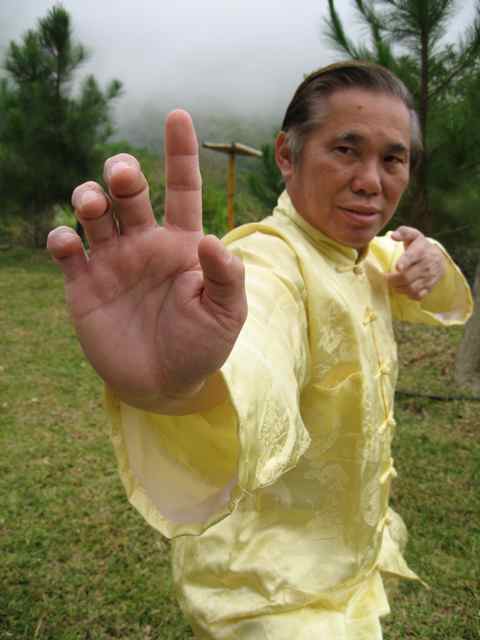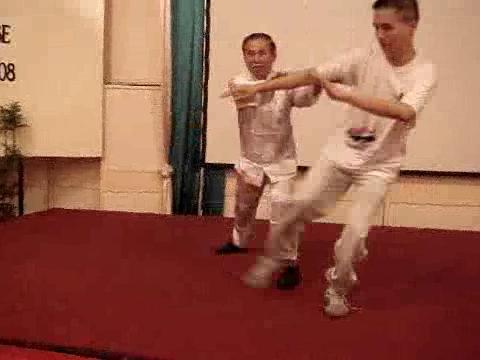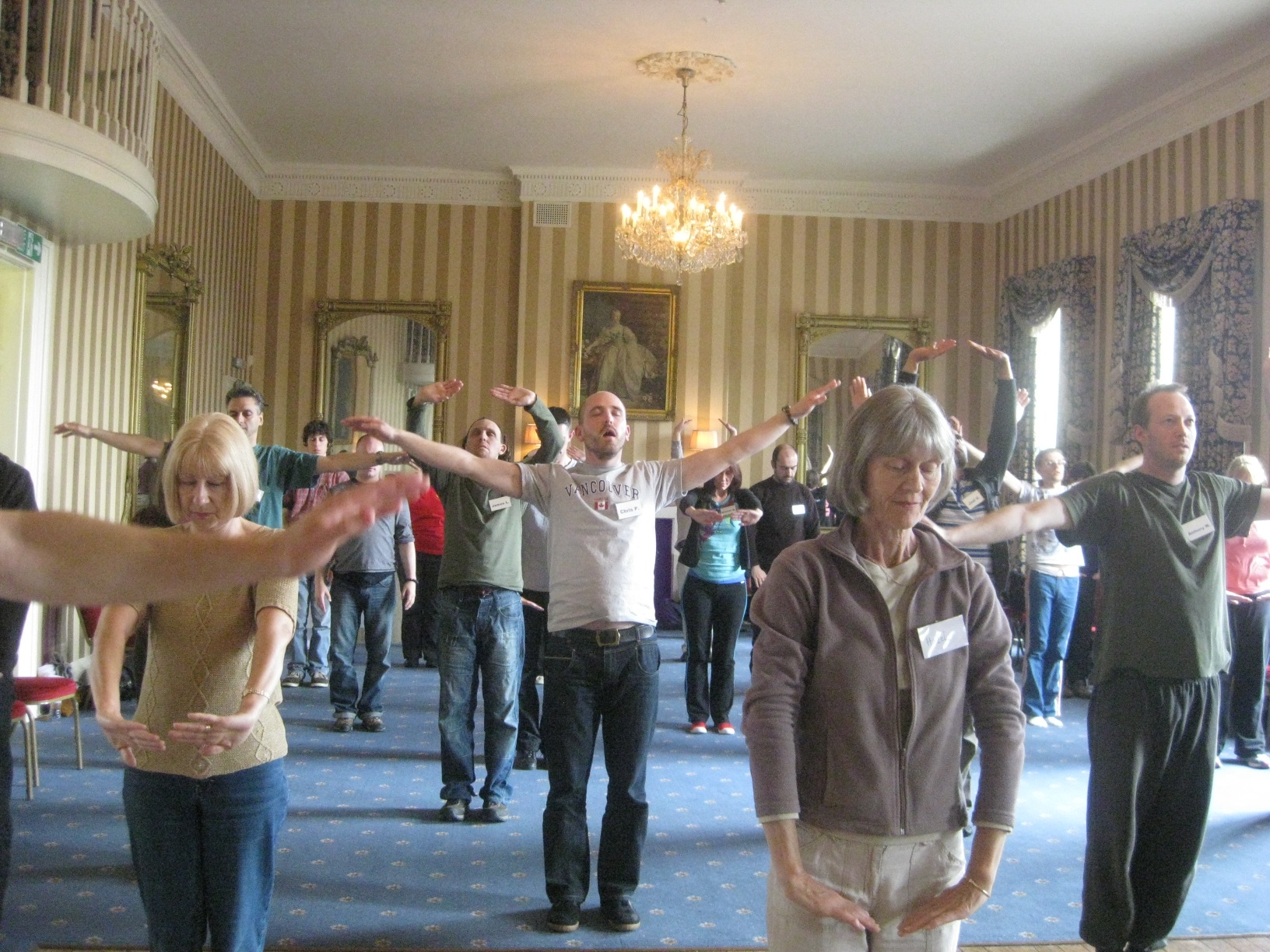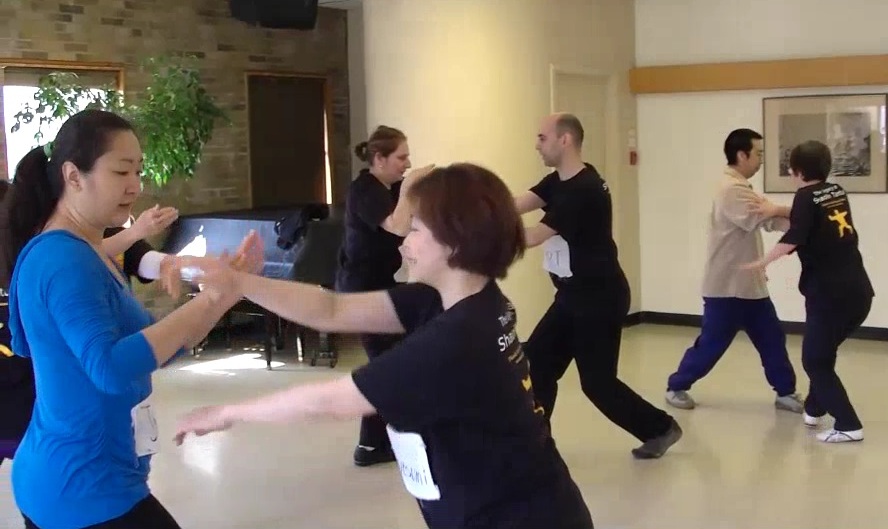SELECTION OF QUESTIONS AND ANSWERS
AUGUST 2015 PART 2

Grandmaster Wong demonstrating "Shooting Arrows"
Question 1
My Tai Chi Chuan class is progressing to level 4 now which is called "Tactics of Pushing Hands". We already worked through all the pushes from all sides in level 3.
Which tactics should I now put special emphasis on in the Pushing Hands practice?
— Sifu Leonard, Austria
Answer
Congratulations for doing well with your Tai Chi Chuan class.
You should put equal emphasis on all the tactics. After students have learnt the tactics individually, you may combine them in suitable situations.
There are four tactics to be taught in Level 4. Two are proactive tactics, which means a practitioner initiates the tactics. The other two are reactive tactics, which means a practitioner uses these tactics when reacting to an opponent.
The two proactive tactics are "continuous attack" and "confusing attack".
In "continuous attack" a practitioner attacks an opponent continuously without giving the opponent a chance to counter attack. It is important to pay attention to "safety first" when implementing this tactic.
In "confusing attack", a practitioner confuses an opponent when attacking him. He may, for example, pretends to attack the opponent's top, then attacks his bottom.
The two reactive tactics are "instantaneous counter" and "interception".
In "instantaneous counter" a practitioner counter attacks an opponent immediately after the opponent has made an attack, without give a chance for the opponent to recover from his previous movement.
In "interception" a practitioner intercepts an opponent's attack, i.e. without letting the opponent complete his attack, and counter-attacks the opponent. It is a development from "immediate counter".
In "immediate counter", the practitioner counter-attacks as soon as an opponent completes his initial attack. In "interception" the practitioner conter-attacks before the opponent completes his initial attack.
It is useful to tell students the difference between a technique and a tactic. If you use "Fierce Dragon Across Stream" to strike an opponent, it is a technique. If you use this technique in a particular way to gain some advantage, it becomes a tactic.
For example, an opponent attacks you, and you ward off his attack. When he has recovered himself, you attack him with the technique, "Fierce Dragon Across Stream".
Now, instead of letting some time pass, you counter-attack him immediately after he completes his attack, giving him no time to recover. You may use the same technique, "Fierce Dragon Across Stream", but you apply this technique in a tactic of instantaneous counter. Your chance of striking him will be higher than in the earlier situation when you allow him to recover after his initial attack.
In the first situation if your opponent knows an appropriate defence technique, he can defend against your attack. In the second situation even when he knows the defence technique, he may be unable to defend against your attack because your use of tactic has put him in a disadvantageous position.
Suppose your opponent is skillful. Despite his disadvantageous position, he can defend against your attack. So you raise your tactic to a higher level. Instead of counter-attacking as soon as he completes his initial attack, you counter-attack in the midst of his attacking movement. You use the tactic of interception. Your chance of striking him is higher.
Suppose he is very skillful. He can defend against your interception. As soon as you complete your first counter-attack, or even before it, you continue with a second attack. You may use the same attacking technique, "Fierce Dragon Across Stream", or you may use another technique.
You chance of hitting him is much higher using this tactic of continuous attack than had you used the same two attacking techniques separately.
Or you may use the tactic of confusion. You pretend to attack his face with "Fierce Dragon Across Stream", and when he tries to defend against your facial attack, you suddenly change your attack to his abdomen using the same attacking technique.
You should also teach your students the use of these tactics in their daily life. It is very important to inculcate in them that their uses must always be for good.
Question 2
Do you have any recommendations for Pushing Hands exercises to train those tactics?
Answer
Before telling students about the tactics, it is helpful to give them a demonstration. Attack a student with a certain technique, and let him defend against it. Then attack him again using the same technique. He will be able to defend against it again.
Next, attack the same student using the same two techniques continuously. If you apply the tactic of continuous attack well, it is likely that he can't defend against your second attack, though earlier he could when you used the same attacking techniques individually.
Explain to the class that the student could not defend against your second attack, not because he did not know the defence technique, but because you had placed him in a disadvantageous situation using the tactic of continuous attack.
In the unlikely event that your student could successfully defend against your continuous attack, compliment him. Explain that most other people could not defend against this tactic of continuous attack though they may be able to defend against the same attacks when applied separately.
After students have practiced Pushing Hands using the newly learned tactics, tell them that the same tactics can be used to enhance our daily lives. Emphasize that their use must always be for good, and never for evil.
Divide the class into groups, and ask them to discuss how to apply the tactics in daily life. Let each group describe their applications and let the others comment on them.

Grandmaster Wong applies the tactic of interception on Edwin
Question 3
Can you please elaborate on their application in real life situations?
Answer
The tactic of continuous attack can be fruitfully used in an argument. Suppose a friend argues that eating ice-cream is not good.
Ask him a question. As soon as he answers, ask him another questions. Continue asking him questions to lead to a conclusion that he says eating ice cream is good.
Here is an example of using the tactic of continuous attack.
"Have you eaten any ice-cream?"
"Yes, I have."
"Did you enjoy it?"
"Yes, but ..."
"Well, it shows ice-cream is good. It brings you enjoyment. Were you sick after eating the ice-cream?"
"No, but ..."
"You were not sick, and you enjoyed it. Ice cream is good for you."
It does not matter what his answers are, though sometimes you may have to modify your subsequent question to suit the answer he has just given. Similarly, in combat it does not matter how your opponent responds to your attack, though you may have to modify your movement for your subsequent continuous attack.
For example, he may answer "No" to your first question.
Then you modify your next question.
"I'm sorry you have missed out something good in life. Most people have eaten ice cream. Do you think they enjoy it?"
"No, I don't think so."
"You're mistaken. They enjoy eating ice-cream or else they would not have eaten it in the first place. Were they sick after eating ice cream."
"Er, I don't know ..."
"Of course they were not sick, and they enjoyed it. You might be an odd exception, but ice-cream is good."
Question 4
I recognized that I somehow executed the frequent closing pattern "One Finger Stabilizing Empire" differently to what I now found in all your videos.
I used to have the open palm of my left "One Finger Zen hand-form" facing me like in the chi kung exercise "Shooting Arrows" before advancing to the end position.
Is this incorrect or just a variation?
Should I change to the typical way?
What are the differences? The typical way feels more forceful to me now.
Answer
Your way of performing "One Finger Stabilizing Empire" is not wrong. It is a variation.
For convenience we shall call the way performed in "Shooting Arrows" the chi kung way, and that in "One Finger Stabilizing Empire" the kungfu way.
As a teacher is a model for his students to follow, it is advisable for you to change to the typical way, which has been established as the best way for its particular purpose. Hence you use the kungfu way when teaching "One Finger Stabilizing Empire", and the chi kung way when teaching "Shooting Arrows".
The main difference is that the kungfu way consolidates energy, whereas the chi kung way lets energy flow. Hence you feel more forceful when you perform the kungfu way, and more flowing when you perform the chi kung way.
Editorial Note: Sifu Leonard's other questions will be continued at August 2015 Part 3 issue of the Question-Answer Series.

Ours is a chi kung and kungfu school, not a retreat for religious or spiritual curiosity or a centre for experimentation
Question 5
In standing meditation a few weeks ago, I had a sudden "realization" that divine and enlightened entities were grand foci of energy and thought from countless beings. I "saw" Guan Yin Bodhisattva in her usual portrayal as a Chinese noblewoman, but when I "looked," I did not see a soul, an intellect, or guiding consciousness behind the image; it just seemed like energy wearing a certain form.
— Fred, USA
Answer
I do not know enough to say whether divine and enlightened entities are grand foci of energy and thoughts from countless beings.
But I believe that the energy or consciousness of Guan Yin Bodh Satt is the energy or consciousness of Guan Yin Bodh Satt, and not of other beings.
If you did not see a soul or an intellect or guiding consciousness in Gaun Yin Bodh Satt, it was because you did not see it, and not because it was not there. In the same way when kungfu practitioners do not experience internal force, it is because they do not experience internal force, and not because internal force is non-existent.
Question 6
For some reason, I thought of "borrowing" some of the energy from the collection of energy that made up the image of Guan Yin Bodhisattva and felt it enter my body. It felt very deep and subtle, making my body vibrate as I gave a blessing for the continued health and happiness of some friends and family members before "returning" the energy back to the collection of energy making up the image of Guan Yin Bodhisattva.
Answer
I would not recommend that you do this, not because it is not a good thing, but because it is unknown.
In our school we learn what has been established, and we are grateful to past masters for passing on their legacy to us. Even if we can accomplish just a small portion of their legacy, it is more than enough to fulfill our needs, which are good health, vitality, longevity, mental freshness and spiritual joys. We should not try to be smarter than them and commit the mistake expressed by the proverb, "fools rush in where angels fear to thread".
This does not mean that we are not innovative, but we must know what we are doing, and also we must know our limitation. Many people have been very kind to use the expression, "tang fong cho kaik", on me, which means "having reached the summit of present development and ready to create new limits". Indeed, many things we practice in our school are innovations based on the legacy of past masters. But I am always conscious of my limitation, and am humble enough to accept it.
But you are venturing into the unknown, and you do not know what you are doing. You presumed that the energy was from Guan Yin Bodh Satt. But your presumption could be wrong. It could be some energy from an imposter, and you would be in series risks, despite some initial benefit to tempt you.
Even if it were the energy of Guan Yin Bodh Satt, it would be disrespectful to freely take the energy from Her, and return it at will as if returning a cooking pot to a neigbour. You may request Guan Yin Bodh Satt to bless you or other people, but not take Her blessings or energy as if it were your right or your own property.

Using kungfu to handle other martial artists should not be difficult
Question 7
The experience left me very curious about the nature of religion and spirituality. The idea of "everything is just energy" has been in my mind a lot lately; so, too, the curious idea that divine and enlightened beings just being collections of energy and thought. Earlier tonight, I did the same thing as before for the first time in a few weeks, "borrowing" energy for a blessing and then "returning" the remaining energy. It felt much the same, and I have to admit I felt very happy and at peace afterwards.
Answer
Remember that ours is a kungfu and chi kung school, not a retreat for religious or spiritual curiosity, and not a centre for experimentation.
What you did deviated from the aims and objectives of our school. You are still a student, though you have good potential to become a master one day. You are not in a position to experiment, not even in a position to make innovation.
Take heed of the saying, "First practice the established. Then respond to its variation." You are still at the first stage of the saying. Leave the second stage to masters.
Excel in what is taught in our school. Learn, for example, to handle other martial artists comfortably and elegantly, no matter how ferociously they rush at you. Be healthy, live life joyfully and be an inspiration to others.
Question 8
I wanted to ask for your wisdom and advice about these experiences. I would like to know if this is something I should avoid doing, or if I can continue, and if it would be all right, if you could share your insight regarding the "realization" I had that divine entities are "just" foci for energy and thoughts. Having no experience at all in a matter like this (I'm used to just practicing qigong and kungfu to cultivate my own energy, not using anyone else's) I want to make sure I'm not doing any wrong or harm with this.
Answer
It is good that you ask me for advice. Many students who had great potential to be masters fell at this stage of their development. They reached a stage where they were far ahead of other students in other schools, a stage where they themselves had not imagined possible before, but without their knowing they were still far from what our arts could bring them.
Some became arrogant, and many started to experiment. But unlike you, they were not humble enough to ask for advice, or follow the advice real masters who had gone through the same path kindly gave them. These students thought they had accomplished much, when actually there was a lot more our arts could give them. It was a real pity seeing them fall.
Yes, this is something you should avoid doing. Not only it would waste a lot of your time and bring you no benefit, it could bring you much harm.
Yours was not a realization but an illusion. Divine entities have a distinct personality and identity of their own. They are not just foci of random energy and thought.
If you have no experience and have no competent teachers to guide you, it is not only unwise but dangerous to indulge in such matter. After all, does it really matter to your daily life that divine entities are just foci of random energy and thoughts, or have a personality of their own? Spend your time in more fruitful and meaningful activities, like enjoying meals with your parents, or enjoying tea yourself while admiring a sunset.
LINKS
Selected Reading
- Understanding Why Taiji Comes from Wuji
- Internal-External Double Cultivation
- A Lesson from the Ireland Course
- 8 Shaolin Distilled Combat Sequences
- Combat Application of Umbrella
